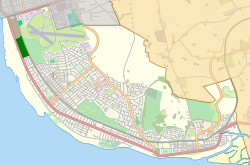Lytham Priory facts for kids
| Monastery information | |
|---|---|
| Order | Benedictine |
| Mother house | Durham Priory |
| Dedicated to | St Cuthbert |
| People | |
| Founder(s) | Richard Fitz Roger |
| Site | |
| Coordinates | 53°44′39″N 2°58′36″W / 53.7441°N 2.9768°W |
Lytham Priory was a special kind of monastery called a priory. It was home to Benedictine monks in Lytham, Lancashire, England.
A man named Richard Fitz Roger started it between 1189 and 1194. It was like a small branch of a much bigger monastery, Durham Priory. The priory was named after Saint Cuthbert. It operated until the 1530s, when King Henry VIII closed down many monasteries in England. Later, in the 1700s, a large house called Lytham Hall was built exactly where the priory used to be.
What was Lytham Priory?
Lytham is a town on the coast of the Fylde in Lancashire. It's near where the River Ribble meets the sea. Lytham was first mentioned in a very old book called the Domesday Book in 1086. Back then, it was known as Lidun.
By the 1100s, there was already a church in Lytham. This church was also dedicated to Saint Cuthbert.
How Lytham Priory Started
Between 1189 and 1194, a man named Richard Fitz Roger made a big gift. He lived in Woodplumpton and gave the church and his land in Lytham to the monks of Durham Priory. He wanted them to build a Benedictine priory there.
Richard Fitz Roger had a special connection to Durham. He believed that Saint Cuthbert had helped him twice. Saint Cuthbert was a very important saint, and many people visited his shrine at Durham. Richard had even traveled to Durham to thank Saint Cuthbert for these miracles. This might be why he decided to give his land to Durham Priory.
It's thought that the monks of Durham didn't own any land in Lytham before this gift. Lytham Priory was a small place. It usually had only two or three monks living there at any time. This was because it was a "cell," meaning it depended on the much larger Durham Priory.
What Happened to the Priory?
In the 1530s, King Henry VIII decided to close down many monasteries in England. This event is known as the Dissolution of the Monasteries.
After the priory closed, its land went to a local landowner named Cuthbert Clifton. In the 1600s, he built a house on the site. This house was later replaced by a grander building. This new building was Lytham Hall, which was built between 1757 and 1764.


